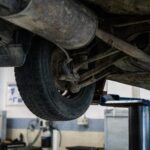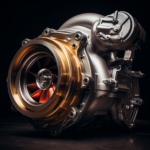Multi-link suspension plays a crucial role in keeping you safe behind the wheel while giving you the freedom to take on any curve or corner with confidence. Its independent suspensions, such as wishbone or longitudinal link setups, work harmoniously with shock absorbers and other components to provide optimal performance.
What is Multi-Link Suspension?
Multi-link suspension is a sophisticated and intricate system that revolutionizes the way a vehicle’s wheels connect to its chassis. Instead of relying on a simple setup like a solid axle or MacPherson strut, multi-link suspension employs multiple links or arms to establish the connection between the wheel hub assembly and the vehicle’s frame.
This type of suspension comprises various components such as control arms, lateral links, trailing arms, and toe links. Each arm plays a crucial role in allowing the wheel to move independently from one another, providing exceptional wheel articulation and ensuring consistent contact with the road surface.
One of the key advantages of multi-link suspension is its ability to finely tune the suspension geometry for optimal performance in different driving conditions. By adjusting the lengths and angles of each link, engineers can precisely control factors like camber (the vertical tilt of the wheel), caster (the angle between steering axis and vertical line), toe-in (wheels pointing inward), and toe-out (wheels pointing outward). This flexibility allows for improved tire wear and enhanced handling characteristics.
In practical terms, imagine you’re driving on a bumpy road with uneven surfaces. With multi-link suspension, each wheel can react independently to these imperfections. As one wheel hits a pothole or bump, it doesn’t transmit those forces directly to other wheels. Instead, it absorbs them individually without affecting the overall stability of your vehicle. This results in better ride quality by reducing vibrations and improving comfort for both driver and passengers.
Moreover, multi-link suspension enhances cornering stability by minimizing body roll during turns. When you take a sharp corner at high speeds, traditional suspensions may cause excessive body lean due to weight transfer. However, with multi-link systems in place, they effectively distribute weight across all four wheels while maintaining optimal tire contact with the road. This translates into improved grip and traction around corners, allowing you to confidently navigate twists and turns.
Usage of Multi-Link Suspension
Enhanced Cornering Ability and Stability at High Speeds
Sports car enthusiasts are well aware of the benefits that multi-link suspension brings to the table. This advanced suspension system is widely employed in high-performance sports cars for one primary reason – enhanced cornering ability and stability at high speeds. By utilizing multiple links and control arms, it effectively minimizes body roll during aggressive maneuvers, allowing drivers to take corners with confidence.
The multi-link suspension setup ensures that each wheel maintains optimal contact with the road surface, even when subjected to extreme lateral forces. This means that when you’re pushing your sports car to its limits on a twisty road or a racetrack, you can expect exceptional grip and precise handling. The improved stability provided by multi-link suspension not only enhances performance but also instills a sense of control and confidence in the driver.
Smooth and Comfortable Ride Quality on Rough Roads
Luxury vehicles are renowned for their ability to deliver a smooth and comfortable ride quality, regardless of the road conditions. One crucial component responsible for this refined driving experience is none other than the multi-link suspension system. By dispersing road imperfections across multiple links, this sophisticated setup helps dampen vibrations and absorb shocks more effectively.
When encountering rough roads or uneven surfaces, luxury vehicles equipped with multi-link suspension ensure that passengers remain undisturbed by providing excellent isolation from harsh impacts. The system’s ability to distribute load evenly among all four wheels also contributes to improved ride comfort since it minimizes jolts felt inside the cabin. So whether you’re cruising along city streets or embarking on a long-distance journey, you can enjoy a plush ride without compromising on handling prowess.
Improved Traction over Uneven Terrain while Maintaining Control
Off-road adventurers require vehicles capable of tackling challenging terrains without sacrificing control or stability. Multi-link suspension systems have found their way into off-road vehicles precisely because of their ability to strike a balance between improved traction and maintaining control over uneven terrain.
When venturing off the beaten path, multi-link suspension ensures that each wheel can independently react to undulations, rocks, and obstacles. This allows for better articulation, ensuring that the wheels remain in contact with the ground more consistently. By maximizing tire grip on challenging surfaces, multi-link suspension helps drivers maintain control even in the most demanding off-road situations.
Balancing Comfort and Agility during Everyday Commuting
Compact cars are often sought after for their practicality and efficiency in urban environments. While comfort may not be their primary focus, manufacturers aim to provide a balanced driving experience by incorporating multi-link suspension systems into these vehicles.
By offering a compromise between comfort and agility, multi-link suspension enhances the everyday commuting experience in compact cars. It absorbs road imperfections effectively while still providing responsive handling characteristics. This means you can navigate through city traffic smoothly while enjoying a level of driving engagement that makes mundane commutes more enjoyable.
Better Handling Dynamics without Compromising Off-Road Capabilities
SUVs have evolved from being purely utilitarian vehicles to versatile machines capable of delivering both on-road performance and off-road prowess. Multi-link suspension systems have been adopted by some SUV models as they offer better handling dynamics without compromising the vehicle’s off-road capabilities.
The use of multi-link suspension allows SUVs to exhibit improved body control during spirited driving on paved roads or winding mountain passes. The system minimizes body roll when cornering, giving drivers increased confidence and stability at higher speeds. Simultaneously, when venturing onto rough terrains or unpaved trails, multi-link suspension ensures that the vehicle can tackle obstacles with ease while maintaining optimal traction.
Advantages of Multi-Link Rear Suspension
Better Handling Precision
One of the key advantages of multi-link rear suspension is its ability to offer better handling precision. By reducing unwanted movements such as body roll or pitch during cornering or braking maneuvers, this advanced suspension system provides drivers with enhanced control and confidence on the road. Imagine taking a sharp turn at high speed without feeling your vehicle lean excessively or losing grip. With multi-link suspension, that’s exactly what you get.
Enhanced Traction
In addition to improved handling, multi-link rear suspension also enhances traction. It keeps the tires firmly planted on the road surface under acceleration or sudden changes in direction, allowing for greater stability and control. Whether you’re accelerating from a standstill or navigating through tight bends, this suspension system ensures that power is efficiently transferred to the wheels, maximizing grip and minimizing wheel spin.
Improved Ride Comfort
Another advantage of multi-link rear suspension is its ability to improve ride comfort. This is achieved through effective shock absorption capabilities that isolate passengers from road imperfections. Bumps, potholes, and uneven surfaces are absorbed by the suspension system, providing a smoother and more comfortable ride for everyone inside the vehicle. Say goodbye to jolts and bumps that leave you feeling shaken up after a long drive.
Independent Wheel Movement
Multi-link rear suspension allows for independent movement of each wheel, preventing one side from affecting the other during uneven road surfaces or obstacles. This means that even if one wheel encounters a bump or dips into a pothole, it won’t negatively impact the other wheels’ performance. Each wheel can react independently to changes in terrain, ensuring optimal contact with the road at all times.
Fine-Tuning Suspension Characteristics
One of the standout features of multi-link rear suspension is its versatility in terms of fine-tuning suspension characteristics. Whether you’re driving on smooth highways or tackling challenging off-road trails, this advanced suspension system can be adjusted to suit specific driving conditions or personal preferences. By tweaking parameters such as damping, spring rates, and anti-roll bar stiffness, drivers can optimize their vehicle’s handling and comfort according to their needs.
Popularity of Multi-Link Rear Suspension
The multi-link rear suspension has been gaining immense popularity in the automotive industry. This advanced suspension system is being increasingly adopted by automakers due to its versatility and the performance benefits it offers. Let’s delve into why this type of rear suspension has become a favorite among enthusiasts and drivers who prioritize handling dynamics and ride quality.
Versatility and Performance Benefits
One of the primary reasons for the widespread adoption of multi-link rear suspension is its versatility. Unlike traditional solid axle suspensions, which can be limiting in terms of adjustability, the multi-link setup allows for greater control over each wheel independently. This means that engineers can fine-tune the suspension settings to optimize handling characteristics, resulting in enhanced stability, improved cornering ability, and reduced body roll.
Moreover, the multi-link rear suspension provides better traction by keeping the rear wheels planted firmly on the road surface. This not only improves acceleration but also enhances braking performance, allowing for shorter stopping distances. The ability to maintain tire contact with the road at all times ensures optimal grip and control, especially during high-speed maneuvers or when driving on uneven surfaces.
Refined Driving Experience
Another key factor contributing to the popularity of multi-link rear suspension is its ability to offer a more refined driving experience. By isolating each wheel from one another through separate links and control arms, this suspension design minimizes unwanted vibrations and harshness transmitted from one side to another. As a result, passengers enjoy a smoother ride with reduced noise levels inside the cabin.
Furthermore, multi-link rear suspension excels at providing a balance between comfort and sporty driving characteristics. It caters to consumers seeking both a comfortable ride during daily commutes and an engaging experience when pushing their vehicles to their limits on twisty roads or racetracks. This versatility makes it an attractive choice for drivers who desire dynamic handling without compromising on overall ride quality.
Widely Available in Mid-Range and High-End Vehicles
The popularity of multi-link rear suspension is further evident in its widespread availability across different segments of vehicles. Once considered a feature exclusive to high-end luxury cars, it has now become a standard offering in many mid-range vehicles as well. Automakers recognize the demand for improved ride quality and handling dynamics among consumers, leading them to incorporate this advanced suspension system into their models.
Whether you’re looking at sedans, SUVs, or even performance-oriented sports cars, chances are you’ll find multi-link rear suspension as an option or standard feature. This accessibility allows a broader range of drivers to experience the benefits of this suspension design without breaking the bank.
Design and Functionality of Multi-Link Suspension
The design and functionality of multi-link suspension systems have revolutionized the way vehicles handle on the road. By utilizing multiple arms or links connected to various points on the wheel hub assembly, these suspension designs allow for complex movement patterns that enhance both comfort and performance.
Each link in a multi-link suspension system has a specific role in controlling wheel motion. For example, some links are responsible for vertical movement, allowing the wheels to absorb bumps and maintain contact with the road surface. Other links handle toe-in/toe-out adjustments, which affect how the wheels align with each other. This adjustability is crucial for optimizing tire wear and ensuring stable handling.
Moreover, lateral stability is another key aspect controlled by specific links in a multi-link suspension system. These links work together to minimize body roll during cornering, providing better control and grip when navigating tight turns. The geometry of a multi-link suspension is carefully designed to optimize suspension kinematics for desired handling characteristics, such as improved steering response or reduced understeer/oversteer tendencies.
To achieve optimal performance while keeping weight down, engineers typically use lightweight materials like aluminum or high-strength steel in constructing components of multi-link suspensions. This allows for improved efficiency without compromising strength or safety. By reducing unsprung mass, which refers to components not supported by the vehicle’s springs (such as wheels and brakes), these lightweight materials contribute to better ride quality and more responsive handling.
In addition to material selection, bushings, ball joints, or bearings are incorporated at connection points within a multi-link suspension system. These elements play a vital role in minimizing friction and allowing smooth articulation between different components. By reducing frictional resistance during movement, these joints ensure that the suspension operates efficiently without unnecessary energy losses.
Conclusion: The Benefits and Future of Multi-Link Suspension
Multi-link suspension has revolutionized the automotive industry, offering a range of benefits that enhance both performance and comfort. As we conclude our exploration of this advanced suspension system, let’s recap its advantages, discuss its popularity, and consider its future potential.
Advantages of Multi-Link Rear Suspension
One of the key advantages of multi-link rear suspension is its ability to provide superior handling and stability. By allowing each wheel to move independently, it minimizes body roll during cornering, ensuring optimal tire contact with the road surface. This translates into improved traction and enhanced control, especially in high-speed maneuvers.
Multi-link suspension offers a smooth and comfortable ride by effectively absorbing bumps and vibrations from uneven road surfaces. The individual links work together to distribute forces evenly across the chassis, reducing impact transfer to the vehicle occupants. This results in a more enjoyable driving experience for both drivers and passengers.
Popularity of Multi-Link Rear Suspension
The popularity of multi-link rear suspension has grown steadily over the years due to its proven performance benefits. Many high-end luxury vehicles utilize this advanced suspension system to deliver an unparalleled level of comfort and handling precision. Furthermore, as technology advances and becomes more affordable, we can expect multi-link suspension to become increasingly common in mainstream vehicles as well.
Design and Functionality of Multi-Link Suspension
The design and functionality of multi-link suspension are complex yet efficient. Its intricate arrangement consists of multiple control arms or links connected to various points on the chassis and wheel hub assembly. These links work together harmoniously to allow independent movement for each wheel while maintaining optimal alignment during dynamic driving conditions.
By carefully engineering these linkages, automakers can fine-tune the suspension characteristics according to specific vehicle requirements. This flexibility enables them to achieve a balance between sporty handling dynamics and comfortable ride quality tailored for different types of vehicles.
Pros and Cons of Using Multi-Link Suspension
Like any engineering solution, multi-link suspension has its pros and cons. On the positive side, it offers improved handling, enhanced comfort, and better stability compared to traditional suspension setups. However, it can be more complex and expensive to manufacture and maintain. The increased number of components may require more frequent inspections and potential repairs.
Nevertheless, the benefits outweigh the drawbacks for those seeking exceptional performance and ride quality in their vehicles.
The Future of Multi-Link Suspension
As automotive technology continues to evolve rapidly, we can anticipate further advancements in multi-link suspension systems. Manufacturers will likely explore new materials and design concepts to make these suspensions lighter, more durable, and even more efficient.
Furthermore, with the rise of electric vehicles (EVs) gaining momentum globally, multi-link suspension can play a crucial role in optimizing EV handling characteristics while maintaining passenger comfort. The adaptability of multi-link suspension makes it well-suited for future vehicle platforms that prioritize efficiency without compromising driving dynamics.
In conclusion, multi-link suspension is a remarkable innovation that has transformed how vehicles handle and perform on the road. Its numerous advantages make it an attractive choice for enthusiasts who value both sporty driving dynamics and a comfortable ride. With ongoing improvements in technology and its increasing popularity among automakers, we can expect multi-link suspension to continue shaping the future of automotive engineering.
Aftermarket or Replacement Suspension Parts
I recommend using Tire Rack to buy suspension components. Whether you want to perform the maintenance yourself or just save money on the parts so your mechanic doesn’t upcharge you, Tire Rack is a great place to shop. They guarantee proper fitment for your vehicle by using a program where you can enter the year, model, make, and trim of your vehicle. They also offer a 30-day return policy on unused items and fast free shipping on every order over $50.

FAQs:
Does multi-link suspension improve fuel efficiency?
Multi-link suspension primarily focuses on enhancing handling performance and ride comfort rather than directly improving fuel efficiency. However, by providing better traction control during acceleration and cornering, it indirectly contributes to overall vehicle efficiency.
Can I retrofit my existing vehicle with multi-link rear suspension?
Retrofitting an existing vehicle with a multi-link rear suspension system is highly challenging due to significant modifications required in terms of chassis design and structural integrity. It is generally not recommended or feasible for most vehicles.
Are multi-link suspensions only found in luxury vehicles?
While multi-link suspension systems are commonly associated with luxury vehicles, they are increasingly being adopted in mainstream and performance-oriented cars as well. As technology advances and becomes more affordable, we can expect to see multi-link suspensions in a wider range of vehicles.
Does multi-link suspension require more maintenance than other types of suspensions?
Multi-link suspension systems may require slightly more maintenance compared to simpler suspension setups due to their increased complexity. Regular inspections of the various linkages and components are recommended to ensure optimal performance and longevity.
Does multi-link suspension improve off-road capability?
Multi-link suspension is primarily designed for on-road performance and ride comfort. While it can provide some benefits off-road, such as improved stability over uneven terrain, dedicated off-road vehicles often utilize specialized suspension systems tailored specifically for rugged environments.





